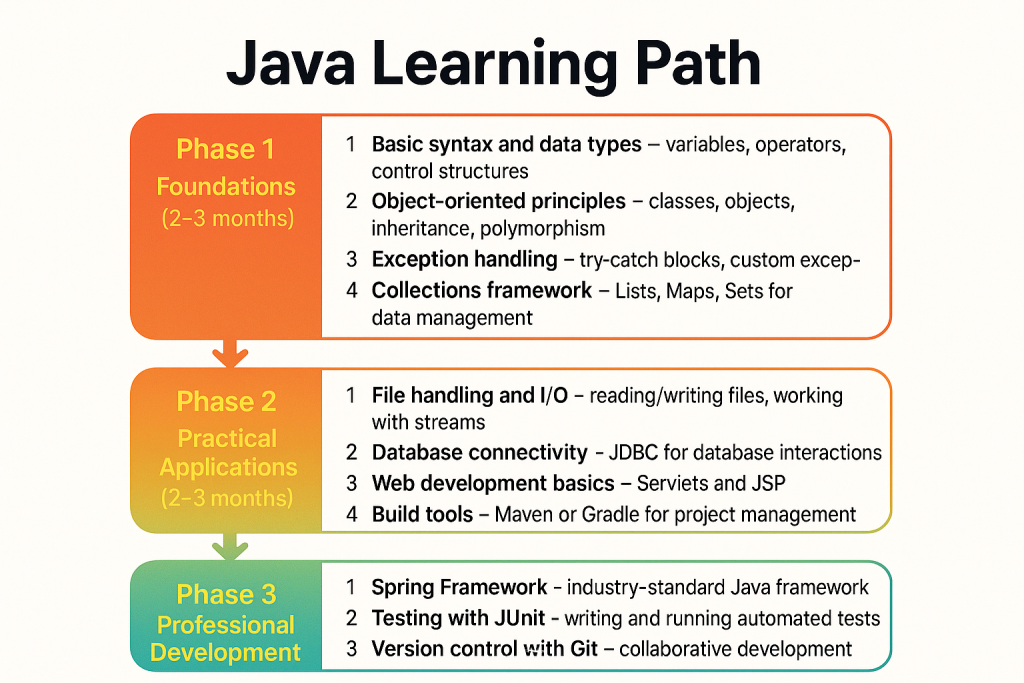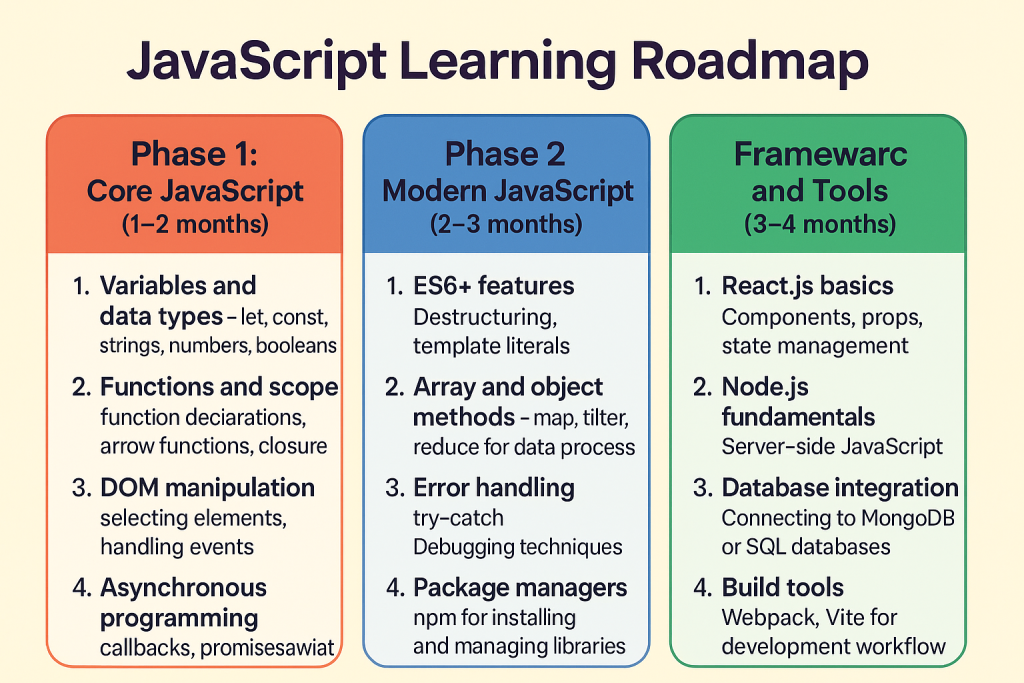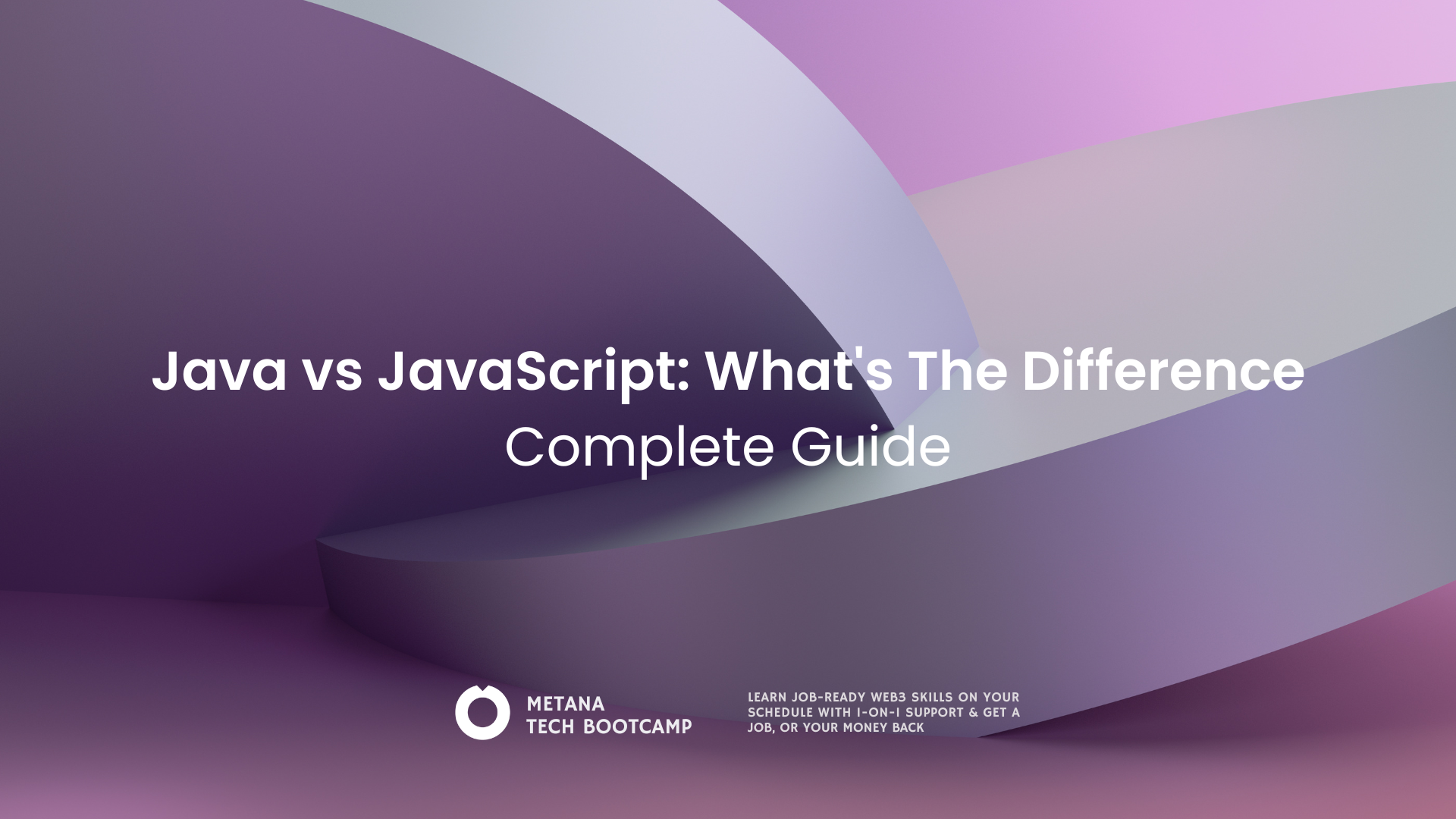What is the difference between Java and JavaScript?
Direct Answer: Java is a compiled, strongly-typed, object-oriented language designed for building platform-independent, large-scale applications, commonly used in enterprise systems and Android development. It runs on the Java Virtual Machine (JVM), enabling “write once, run anywhere” portability, while JavaScript is an interpreted, dynamically-typed, versatile scripting language that enables interactive webpages and powers applications across browsers, servers (Node.js), mobile apps, and desktop platforms.
Java and JavaScript have absolutely nothing in common except their names. It’s like comparing “car” and “carpet”…the similarity ends at the first few letters.
By the end of this guide, you’ll know which language fits your goals and personality as a programmer.
Here’s a reality check: over 97% of websites use JavaScript, while Java powers some of the world’s largest enterprise blockchain solutions. Both languages can launch your Web3 career, but they’ll take you down completely different paths.
Why “Java” appears in both names? Java vs JavaScript
Are Java and JavaScript related just because they share “Java” in their names?
The short answer is no Java and JavaScript are not related.
Here’s the real story behind their confusingly similar names:
Java’s Origin Story

Java
Java was born in 1991 when James Gosling at Sun Microsystems set out to create a language for interactive television. The project initially flopped – turns out the cable TV industry wasn’t ready for Java’s advanced features. But Java found its true calling in desktop applications and server-side programming.
When Java officially launched in 1996, it came with a bold promise: “Write once, run anywhere.” This meant your Java code could run on any device with a Java Virtual Machine (JVM) – whether it’s a Windows PC, Mac, or Linux server.
Knowledge Perks:
The Java Virtual Machine (JVM) is a software-based engine that runs Java bytecode. It serves as a bridge between Java programs and the computer’s hardware, translating the code into instructions the system can execute. By doing so, it provides a runtime environment that allows Java applications to operate across various platforms and operating systems. Taken from: What is the JVM?
JavaScript’s 10-Day Sprint

JavaScript has a completely different origin story. In 1995, Brendan Eich at Netscape was given just 10 days to create a scripting language for web browsers. Ten days! Most people need longer than that to decide on a Netflix show.
The language went through multiple names: first Mocha, then LiveScript, and finally JavaScript (JS).
Here’s the kicker – Netscape’s management chose “JavaScript” purely to capitalize on Java’s growing popularity. It was a marketing decision, nothing more.
JavaScript was designed to make static web pages come alive; adding animations, interactive forms, and dynamic content that could respond to user clicks and inputs.
The Reality Check
So despite sharing “Java” in their names, these languages are fundamentally different. Java powers enterprise servers and Android apps, while JavaScript makes websites interactive and runs everything from Netflix’s interface to Discord’s desktop app.
Think of it this way: Java is like a reliable pickup truck built for heavy-duty work, while JavaScript is like a Swiss Army knife that can handle dozens of different tasks. Both are incredibly useful, but for completely different reasons.
What is Java: The Enterprise Foundation
Java is a compiled, object-oriented programming language that’s been the backbone of enterprise software since 1995. Basically, your code is first turned into a special form called bytecode by a program called a compiler. This bytecode is not tied to any one device and can run anywhere as long as there is a Java Virtual Machine (JVM) available.
The JVM works like a small computer inside your computer, translating the bytecode into instructions your device understands. This is what makes Java portable. You can write your code once and run it almost anywhere.
Java is also statically typed, which means you have to be clear about the type of data you are working with from the start. For example, you might say “this is text” or “this is a number.” Once you choose a type, you cannot switch it to something else later. This makes Java more predictable and less prone to certain errors, but it can also make it a bit stricter and take more time to learn compared to some other languages.
Here’s what defines Java:
- Platform independent – write once, run anywhere through the Java Virtual Machine (JVM)
- Strongly typed – catches errors before your program runs
- Object-oriented – everything is built around classes and objects
- Memory managed – automatic garbage collection handles cleanup
Major companies that bet their businesses on Java include:
Netflix – handles 200+ million subscribers
Goldman Sachs – powers critical financial systems
Uber – manages millions of rides globally
Airbnb – processes booking transactions worldwide
JavaScript: The Web’s Native Language
JavaScript started as a simple browser scripting language but evolved into a full-stack powerhouse. It’s the only language that runs natively in every web browser without plugins or installations which means you do not need a separate compilation step.
You can write it and run it directly in any modern web browser. It is also a dynamically typed language, and you do not have to declare the type of data you are using. You can store text, numbers, or other types of information in the same variable and change it whenever you want. This gives JavaScript a lot of freedom and flexibility.
Key JavaScript characteristics:
- Interpreted language – no compilation step needed
- Dynamically typed – variables can change types during execution
- Event-driven – responds to user clicks, form submissions, page loads
- Versatile – runs in browsers, servers, mobile apps, and desktop applications
Want to learn how JavaScript works? Read this guide to know how it works starting from how its engine works to its powerful applications.
Every website you’ve ever visited uses JavaScript. From Google’s search suggestions to Amazon’s shopping cart – it’s all JavaScript making the web interactive.
Fun Fact: JavaScript isn’t Java with “Script” added to it. The name was a marketing decision from 1995 that still confuses people today.
Major Differences Between Java and JavaScript
Summarized table: Java vs JavaScript
| No. | Aspect | Java | JavaScript |
|---|---|---|---|
| 1 | Compilation vs Interpretation | Requires compilation before running. You write Java code, compile it to bytecode, and run it on the JVM. Pros: faster execution once compiled, errors caught before running. Cons: more setup for beginners. | Runs immediately without compilation. You can run it in any browser or Node.js environment. Pros: instant feedback, quick prototyping. Cons: some errors only show when running. console.log("Hello World!") |
| 2 | Type Systems and Error Handling | Statically typed — you must declare variable types and they cannot change. Prevents many beginner mistakes but requires more learning upfront. | Dynamically typed — variables can change types freely. Easier to start but can cause unexpected bugs later. |
| 3 | Execution Environments | Runs on the JVM and is used for desktop apps, web servers, enterprise software, Android apps, and big data systems. | Runs in browsers (websites, web apps), Node.js (server-side apps), React Native (mobile apps), and Electron (desktop apps like Discord, Slack). |
| 4 | Programming Paradigm | Purely object-oriented — all code must be inside a class, and you need objects to use methods. | Multi-paradigm — supports functional, object-oriented, and procedural styles. Beginners can start with simple functions and move to objects later. |
| 5 | Performance & Speed | Usually faster because Java code is compiled into bytecode and optimized by the JVM. Good for high-performance, large-scale systems. | Generally slower than Java for heavy processing because it’s interpreted (though Node.js and modern JS engines are much faster now). Best for interactive, real-time applications in the browser. |
Understanding these fundamental differences will help you choose the right language for your goals.
1. Compilation vs Interpretation
Java requires compilation before it runs:
java
<em>// HelloWorld.java - must be compiled first</em>
public class HelloWorld {
public static void main(String[] args) {
System.out.println("Hello World!");
}
}You write Java code, compile it to bytecode, then run it on the JVM. This extra step means:
- Faster execution once compiled
- Errors caught before the program runs
- More setup required for beginners
JavaScript runs immediately:
javascript
<em>// No compilation needed - runs directly</em>
console.log("Hello World!");You write JavaScript and run it instantly in any browser or Node.js environment. This means:
- Immediate feedback while learning
- Faster prototyping and testing
- Some errors only appear when code actually runs
2. Type Systems and Error Handling
This difference affects how you write and debug code daily.
Java’s static typing requires declaring variable types:
java
String name = "John"; <em>// Must be a string</em>
int age = 25; <em>// Must be an integer</em>
boolean isStudent = true; <em>// Must be true/false</em>
<em>// This would cause a compile error:</em>
<em>// age = "twenty-five"; // Can't assign string to int</em>JavaScript’s dynamic typing lets variables change:
javascript
let name = "John"; <em>// Currently a string</em>
let age = 25; <em>// Currently a number</em>
<em>// This is perfectly valid:</em>
age = "twenty-five"; <em>// Now it's a string</em>
name = true; <em>// Now it's a boolean</em>For beginners, Java’s strict typing prevents many common mistakes but requires more initial learning. JavaScript’s flexibility speeds up learning but can create confusing bugs later.
Knowledge Perks:
JavaScript errors come in three main types:
1. Syntax Errors – grammar mistakes like missing commas or brackets. These are usually caught by the browser right away.
2. Runtime Errors – hidden until the code runs, like trying to use something undefined.
3. Logical Errors – when your code runs but gives the wrong result despite being technically correct.
Wrap it safely
The try…catch structure is your safety net. Place risky code in try, handle mistakes gracefully in catch, and even use finally for cleanup that runs no matter what.
Debug like a detective
Console logs let you peek at values and code flow.
Browser DevTools are powerhouse tools: set breakpoints, step through code, inspect variables, and track the call stack step-by-step.
Prevent, don’t just catch
Validate user inputs before using them.
Use typeof or instanceof to check data types ahead of time.
Throw your own custom errors with clear messages when something goes wrong unexpectedly.
This was taken from article: JavaScript Error Handling
3. Execution Environments
Where and how your code runs makes a huge difference in what you can build.
Java runs on the Java Virtual Machine:
- Desktop applications (like IntelliJ IDEA, Eclipse)
- Web servers and enterprise applications
- Android mobile apps
- Big data processing systems
JavaScript runs in multiple environments:
- Browsers – interactive websites and web applications
- Node.js – server-side applications and APIs
- Mobile apps – through frameworks like React Native
- Desktop apps – using Electron (like Discord, Slack)
4. Object-Oriented vs Multi-Paradigm Programming
The way you structure and organize your code differs significantly between these languages.
Glossary:
Control structures in JavaScript are tools that guide the flow of your program. They let you decide what code should run, repeat certain actions, or change the execution path depending on conditions. Using them well helps you create code that is smarter, more flexible, and more efficient.
Taken from the article: Control Structures of Java Script
Java is purely object-oriented:
java
<em>// Everything in Java must be inside a class</em>
public class Calculator {
private int result;
public int add(int a, int b) {
this.result = a + b;
return this.result;
}
}
<em>// You must create objects to use methods</em>
Calculator calc = new Calculator();
int sum = calc.add(5, 3);Java forces you to think in terms of objects and classes from day one. Every piece of functionality must belong to a class, which teaches good organizational habits but can feel restrictive for simple tasks.
JavaScript supports multiple programming styles:
javascript
<em>// Functional approach - just write functions</em>
function add(a, b) {
return a + b;
}
<em>// Object-oriented approach - create objects when needed</em>
const calculator = {
result: 0,
add: function(a, b) {
this.result = a + b;
return this.result;
}
};
<em>// Both work fine - use whatever fits the task</em>
let sum1 = add(5, 3); <em>// Simple function call</em>
let sum2 = calculator.add(5, 3); <em>// Object method call</em>JavaScript’s flexibility lets beginners start with simple functions and gradually learn object-oriented concepts as they become more advanced.
5. Performance and Speed
When it comes to raw speed, Java usually has the upper hand. Since Java code is compiled into bytecode and runs on the super-optimized Java Virtual Machine (JVM), it’s like giving your program a head start before it even begins. This makes it great for big, performance-heavy systems like banking software, enterprise applications, or massive backend services that need to process huge amounts of data quickly.
JavaScript, on the other hand, is interpreted, meaning the browser (or Node.js) reads and runs your code line-by-line as it goes. This makes it slightly slower for heavy crunching, but don’t underestimate it—modern JavaScript engines like Google’s V8 are incredibly fast, and for most web apps, games, or interactive sites, you won’t even notice the difference. In short, if you’re building a data-processing powerhouse, Java shines; if you’re making snappy, interactive experiences, JavaScript can keep up just fine.
Learning Curve: Which Is Easier for Beginners?
Both languages can be learned by beginners, but they offer very different experiences.
JavaScript’s Immediate Gratification
JavaScript gives you visual results fast. Within your first hour, you can:
- Make text appear and disappear on a webpage
- Respond to button clicks
- Change colors and styles dynamically
- Create simple animations
This immediate feedback keeps beginners motivated. You see results instantly, which makes learning feel rewarding.
What makes JavaScript beginner-friendly:
- No installation required – any browser works
- Forgiving syntax that lets small mistakes slide
- Huge community with solutions to every problem
- Visual results that make learning engaging
Where JavaScript can frustrate beginners:
- Loose error checking can hide problems until later
- Too much flexibility can lead to bad coding habits
- Debugging can be tricky with dynamic typing
- Overwhelming number of frameworks and libraries
Java’s Structured Learning Path
Java enforces good programming practices from day one. You’ll learn:
- Proper code organization through classes and packages
- Strong typing that prevents many common errors
- Object-oriented principles that apply to other languages
- Professional development practices
What makes Java good for learning:
- Clear error messages that help you fix problems
- Structured approach builds solid foundations
- Transferable skills to other programming languages
- Industry-standard practices from the beginning
Java’s challenges for beginners:
- More setup required before you can start coding
- Verbose syntax can be overwhelming initially
- Abstract concepts like objects and classes need time to understand
- Less immediate visual feedback compared to web development
Common Beginner Mistakes And Solutions in Each Language
JavaScript beginners often struggle with:
- Using
varinstead ofletorconst
Problem: This can cause variables to behave unexpectedly becausevarhas function scope instead of block scope.
Solution: Useletfor variables that may change andconstfor variables that should stay constant. This makes your code easier to understand and prevents accidental changes. - Not understanding asynchronous programming
Problem: Beginners often expect JavaScript to run code line by line in order, but functions likesetTimeoutor network requests run later, not immediately.
Solution: Learn how promises andasync/awaitwork to handle tasks that happen in the future. This makes your code easier to follow and avoids timing issues. - Trusting loose equality (
==vs===)
Problem: Loose equality can give surprising results because it changes types before comparing.
Solution: Use strict equality (===) to ensure both value and type match, which makes comparisons predictable. - Creating complex chains of callbacks
Problem: Writing too many nested callbacks makes code difficult to read and maintain.
Solution: Use promises orasync/awaitto make your asynchronous code look more like normal step-by-step code.
Understand the basic functions of JavaScript before you go ahead!
Java beginners typically face:
- Forgetting to instantiate objects before using them
Problem: This leads to errors because the object does not exist yet when you try to use it.
Solution: Always create an object usingnew ClassName()before calling its methods or accessing its data. - Confusion between classes and objects
Problem: Some beginners think a class is the actual data, not just the blueprint for objects.
Solution: Remember that a class is a design, while an object is the real thing created from that design. Practice by making a class, then creating multiple objects from it. - Not understanding static versus instance methods
Problem: Static methods belong to the class itself, while instance methods belong to the objects created from that class.
Solution: Use static methods for operations that do not depend on specific object data, and use instance methods for operations that act on individual objects. - Memory leaks from not closing resources properly
Problem: Forgetting to close file streams, database connections, or network sockets can waste memory and slow down applications.
Solution: Always close resources when you are done using them, ideally in afinallyblock or by using Java’s try-with-resources feature.
Salaries for Java and JavaScript Developers
How much you make as a Java or JavaScript developer can change a lot depending on where you live, how much experience you have, and the kind of industry you work in. What we will be presenting will be the salary ranges in general in the USA.
On average, Java developers tend to make a bit more money in comparison to JavaScript Developers. That is because Java has been around for a long time and is used in big, complicated systems in industries like banking, healthcare, and manufacturing. These jobs often pay well because they need people with solid technical skills who can handle large, important projects.
JavaScript developers are doing just fine too. While the pay is sometimes a little lower on average, JS is everywhere in modern tech. It powers websites, mobile apps, and even full-stack platforms. Companies like Google, Amazon, and Airbnb use it every day, and the demand for good JavaScript developers is only growing.
Here’s a summarized salary table for you (Source: Glassdoor):
| Career Path | Java Developer Salary Range | JavaScript Developer Salary Range |
|---|
| Enterprise / Frontend | $85,000 – $130,000 | $65,000 – $110,000 |
| Mobile Development | $75,000 – $125,000 | $70,000 – $120,000 |
| Backend / Full-Stack | $90,000 – $140,000 | $75,000 – $125,000 |
| Big Data / DevOps | $100,000 – $160,000 | $80,000 – $130,000 |
How to Get Started as a Java or JavaScript Developer
If you enjoy solving problems and creating things on a computer, becoming a Java or JavaScript developer can be a great path. There is no single “right” way to get there, but most successful developers build their skills through a mix of learning, practice, and community. Here’s a roadmap you can follow:
1. Learn the core ideas of programming
Before you dive into Java or JavaScript, make sure you understand the building blocks of coding; things like variables, loops, functions, and how to think logically about problems. A good beginner-friendly book or online course can give you this foundation.
2. Pick your language and start coding
Once you are comfortable with the basics, choose Java or JavaScript and start learning the syntax, features, and best practices of that language. Keep it hands-on — write small snippets of code as you go so the concepts stick.
Here’s what you can go with: best programming languages
3. Build real projects
Theory is important, but practice is where the magic happens. Start with simple projects like a basic calculator, a quiz app, or a to-do list. Then challenge yourself with bigger ideas…maybe a weather app, a blog platform, or a mini-game. Each project will teach you something new and give you work you can add to your portfolio.
4. Join the developer community
You do not have to learn alone. Participate in online spaces like Stack Overflow, GitHub, or Discord groups for coders. You can share your progress, ask for advice, contribute to open-source projects, and learn from people who have been where you are now.
5. Choose your learning path
Some people teach themselves using online tutorials and free resources. Others study computer science at university. Many join coding bootcamps for a faster, structured approach. Pick what fits your learning style, schedule, and budget.
If you want a complete guide: read our blog on where you can learn these online!
6. Level up with guided training
If you want a faster route into the field, a program like our Software Engineering Bootcamp can help. You will learn JavaScript from day one, work on projects that simulate real-world tasks, and get personal feedback from experienced mentors. Plus, you will have career support for building your resume, practicing interviews, and connecting with hiring partners.
Which Language Should You Learn First?
Your choice depends on your personality, goals, and how you prefer to learn.
Choose JavaScript If…
You want to see results quickly and build things people can interact with immediately. JavaScript is perfect for:
Visual learners who need to see their code working Creative types who want to build interactive experiences Career changers who need to get job-ready quickly Entrepreneurs planning to build web-based products
Specific scenarios where JavaScript makes sense:
- You want to freelance and build websites for local businesses
- You’re interested in startups and modern tech companies
- You prefer learning by building projects you can share online
- You want to work remotely or as a digital nomad
Choose Java If…
You prefer structured learning and want to build a strong programming foundation. Java suits:
Analytical thinkers who appreciate clear rules and structure Detail-oriented people who want to catch errors earlyCareer-focused individuals targeting enterprise roles Long-term planners who want stable, well-paying careers
Specific scenarios where Java makes sense:
- You’re targeting large corporations or government jobs
- You want to work in finance, healthcare, or enterprise software
- You prefer job security over cutting-edge technology
- You’re comfortable with longer learning curves for better foundations
The Multi-Language Reality
Professional developers rarely use just one language.
Most software projects use multiple technologies:
- Frontend: JavaScript, HTML, CSS
- Backend: Java, Python, or Node.js (JavaScript)
- Database: SQL
- Mobile: Java/Kotlin for Android, Swift for iOS, or JavaScript for cross-platform
The language you choose first should align with your immediate goals, but plan to learn others as your career progresses.
PRO TIP: Many successful developers start with JavaScript for quick wins, then learn Java for better career opportunities in enterprise roles.
Learning Resources and Next Steps
Here are proven learning paths for both languages:
Java Learning Path

Phase 1: Foundations (2-3 months)
- Basic syntax and data types – variables, operators, control structures
- Object-oriented principles – classes, objects, inheritance, polymorphism
- Exception handling – try-catch blocks, custom exceptions
- Collections framework – Lists, Maps, Sets for data management
Phase 2: Practical Applications (2-3 months)
- File handling and I/O – reading/writing files, working with streams
- Database connectivity – JDBC for database interactions
- Web development basics – Servlets and JSP
- Build tools – Maven or Gradle for project management
Phase 3: Professional Development (3-4 months)
- Spring Framework – industry-standard Java framework
- Testing with JUnit – writing and running automated tests
- Version control with Git – collaborative development
- Deployment and packaging – creating distributable applications
Recommended Java resources:
- Oracle’s Java Tutorials (free, official documentation)
- “Head First Java” by Kathy Sierra (book for visual learners)
- Codecademy Java Course (interactive online learning)
- IntelliJ IDEA Community Edition (free professional IDE)
JavaScript Learning Roadmap

Phase 1: Core JavaScript (1-2 months)
- Variables and data types – let, const, strings, numbers, booleans
- Functions and scope – function declarations, arrow functions, closure
- DOM manipulation – selecting elements, handling events, changing content
- Asynchronous programming – callbacks, promises, async/await
Phase 2: Modern JavaScript (2-3 months)
- ES6+ features – destructuring, template literals, modules
- Array and object methods – map, filter, reduce for data processing
- Error handling – try-catch, debugging techniques
- Package managers – npm for installing and managing libraries
Phase 3: Framework and Tools (3-4 months)
- React.js basics – components, props, state management
- Node.js fundamentals – server-side JavaScript, Express.js
- Database integration – connecting to MongoDB or SQL databases
- Build tools – Webpack, Vite for development workflow
Recommended JavaScript resources:
- Metana JavaScript blog resources
- freeCodeCamp JavaScript Course (free, comprehensive curriculum)
- “Eloquent JavaScript” by Marijn Haverbeke (free online book)
- MDN Web Docs (definitive JavaScript reference)
- Visual Studio Code (free editor with excellent JavaScript support)
Frequently Asked Questions
1. I am a complete beginner. Should I start with Java or JavaScript?
JavaScript is usually the easier starting point because you can try it right in your web browser without installing anything. You can also see visual results quickly, which makes learning more engaging. Java takes more setup and has a steeper learning curve at first, but it can give you a stronger foundation in programming.
2. Which pays more, Java or JavaScript?
Java tends to offer higher salaries in enterprise jobs, often between 85,000 dollars and 140,000 dollars. JavaScript salaries range from about 65,000 dollars to 130,000 dollars, depending on the role. In both cases, where you live, how much experience you have, and your area of specialization can make a big difference.
3. Can I learn Java and JavaScript at the same time?
You could, but it is not the best idea if you are brand new to coding. The two languages are very different, and learning them together can cause confusion. It is better to focus on one for a few months until you feel confident, then start learning the other. Many developers eventually become skilled in both.
4. Which language gives better job security?
Java often has the advantage here, especially in large companies that run long term projects. These roles can be stable for years. JavaScript also offers many opportunities, but the market moves quickly and trends can change often. Either way, both languages are in high demand.
5. How long will it take me to get job ready in Java or JavaScript?
If you practice every day, you might be ready for a junior JavaScript role in about four to six months. For Java, it is often six to nine months because there is more setup and additional tools and frameworks to learn. In both cases, building real projects is just as important as studying the language itself.








